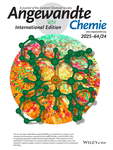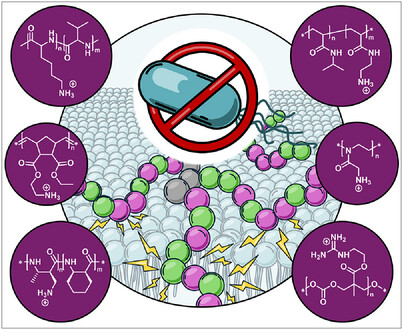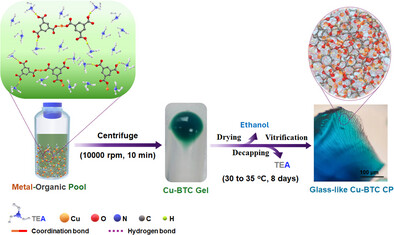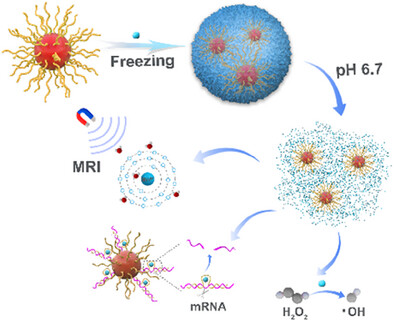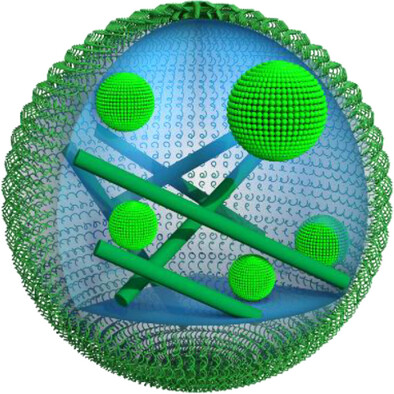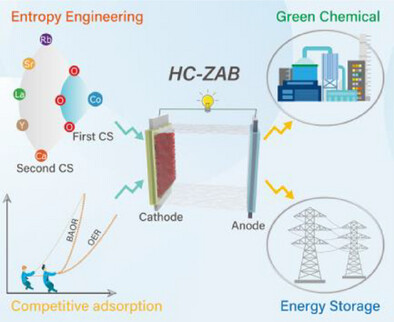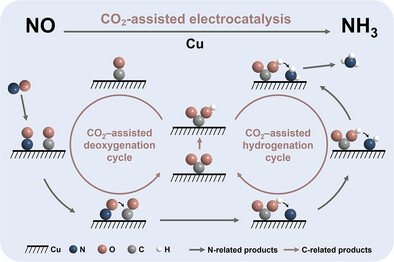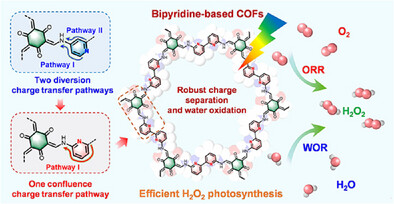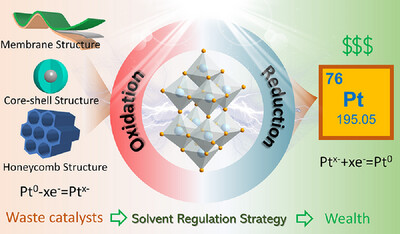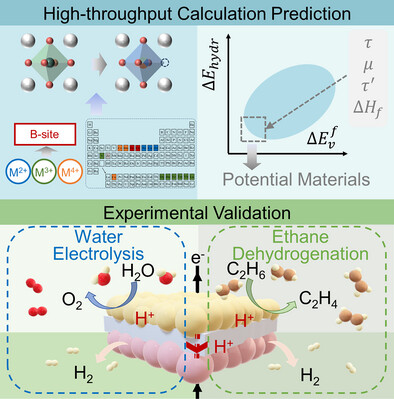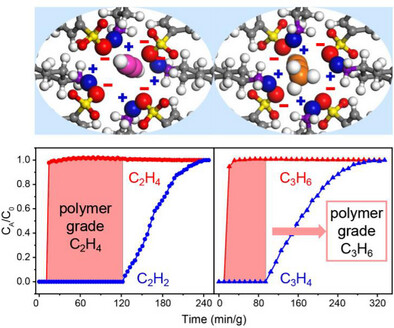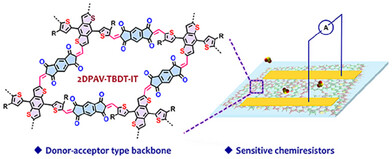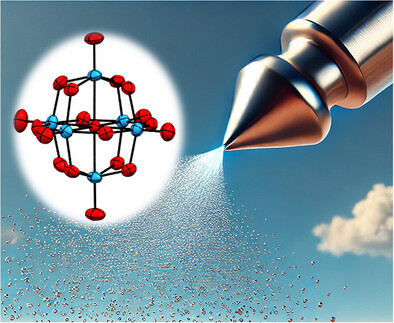Journal list menu
Export Citations
Download PDFs
Cover
Outside Front Cover: A Bench-stable Fluorophosphine Nickel(0) Complex and Its Catalytic Application (Angew. Chem. Int. Ed. 24/2025)
- First Published: 20 May 2025
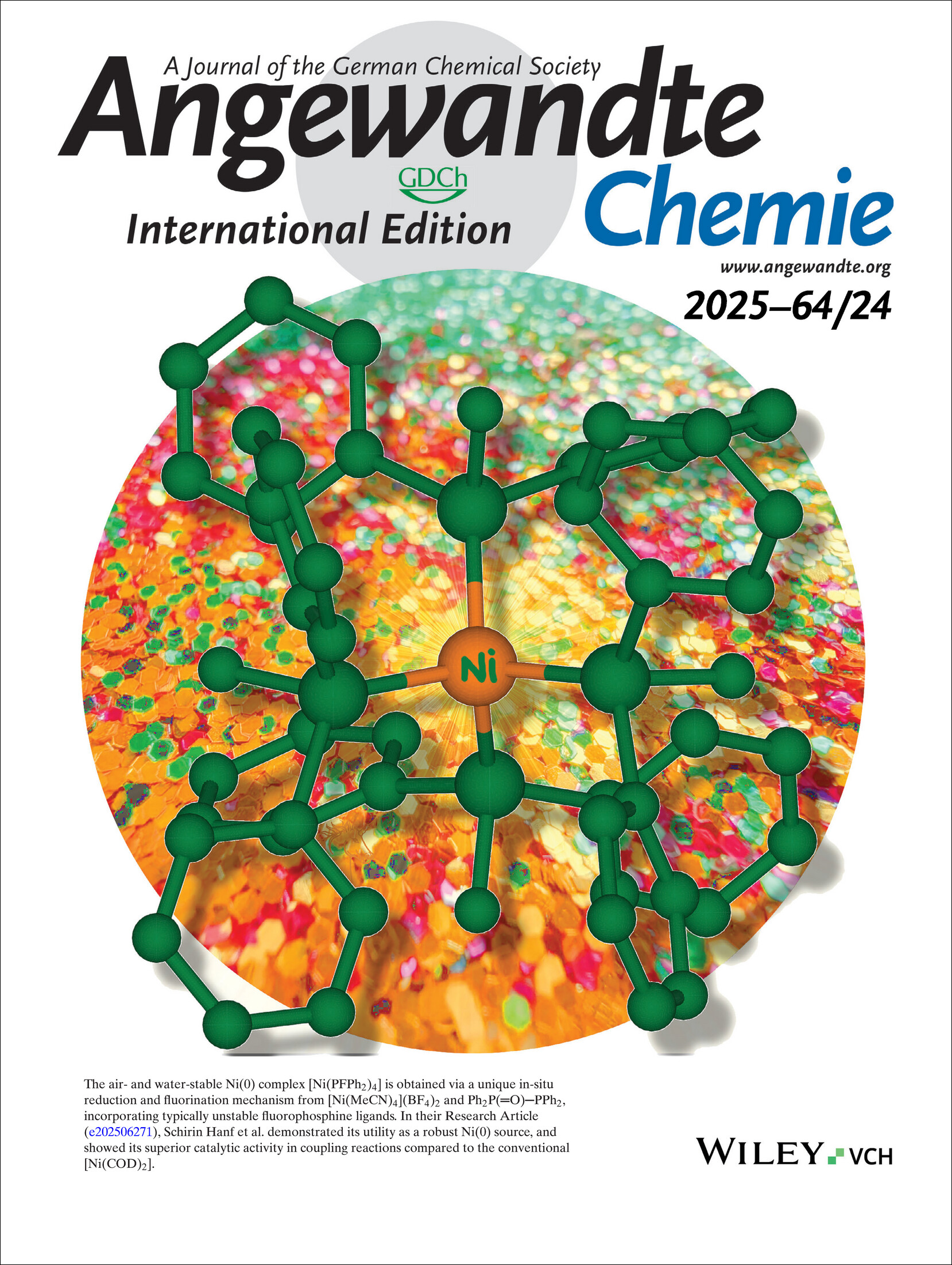
The air- and water-stable Ni(0) complex [Ni(PFPh2)4] is obtained via a unique in-situ reduction and fluorination mechanism from [Ni(MeCN)4](BF4)2 and Ph2P(═O)─PPh2, incorporating typically unstable fluorophosphine ligands. In their Research Article (e202506271), Schirin Hanf et al. demonstrated its utility as a robust Ni(0) source, and showed its superior catalytic activity in coupling reactions compared to the conventional [Ni(COD)2].
Inside Front Cover: Optimizing the Selectivity of CH4 Electrosynthesis from CO2 over Cuprates through Cu─O Bond Length Descriptor (Angew. Chem. Int. Ed. 24/2025)
- First Published: 20 May 2025
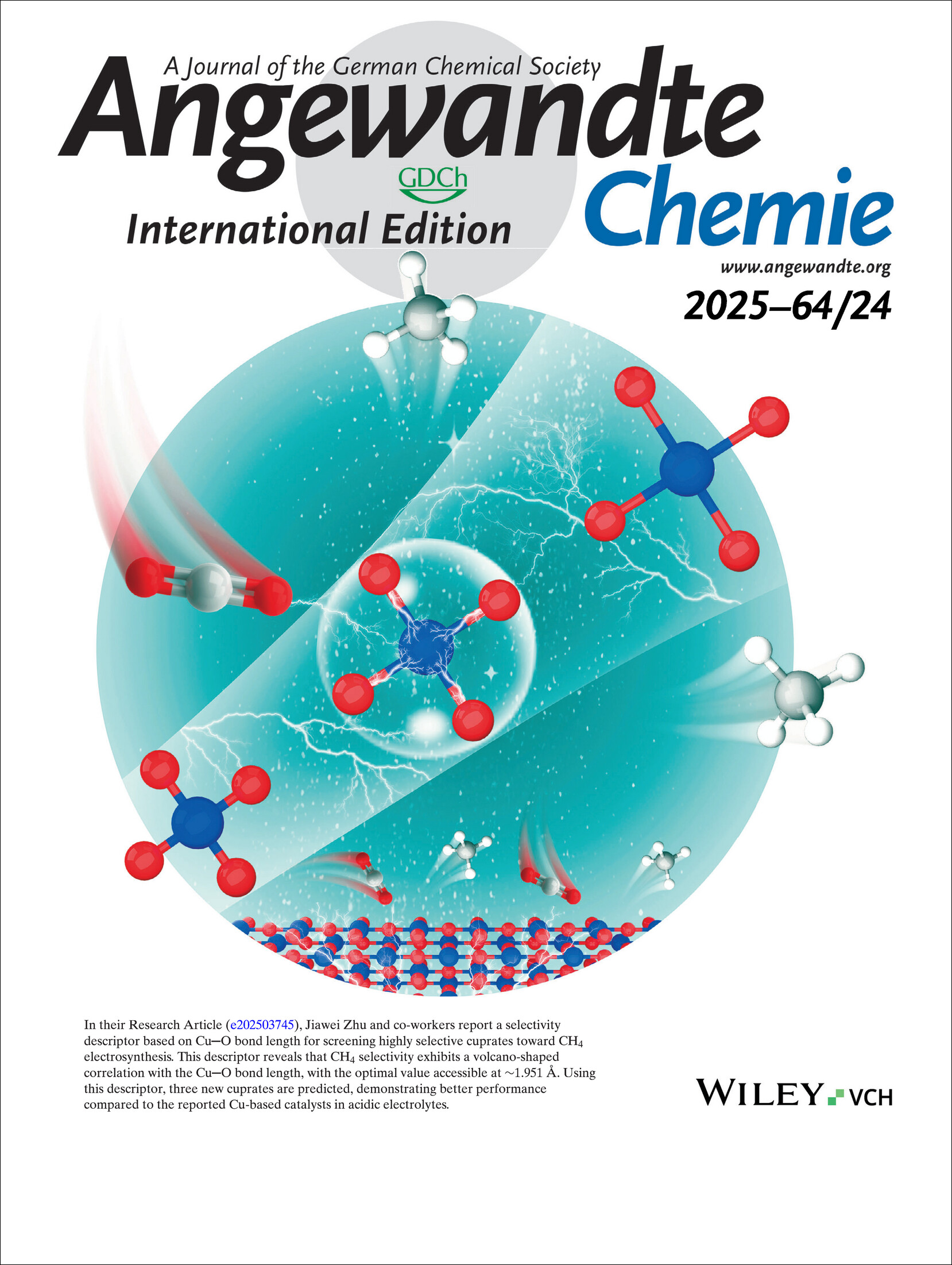
In their Research Article (e202503745), Jiawei Zhu and co-workers report a selectivity descriptor based on Cu─O bond length for screening highly selective cuprates toward CH4 electrosynthesis. This descriptor reveals that CH4 selectivity exhibits a volcano-shaped correlation with the Cu─O bond length, with the optimal value accessible at ∼1.951 Å. Using this descriptor, three new cuprates are predicted, demonstrating better performance compared to the reported Cu-based catalysts in acidic electrolytes.
Inside Back Cover: Cyclo-P5 − Revisited: The Surprisingly Stable Uncoordinated Pentaphospholide Anion (Angew. Chem. Int. Ed. 24/2025)
- First Published: 20 May 2025
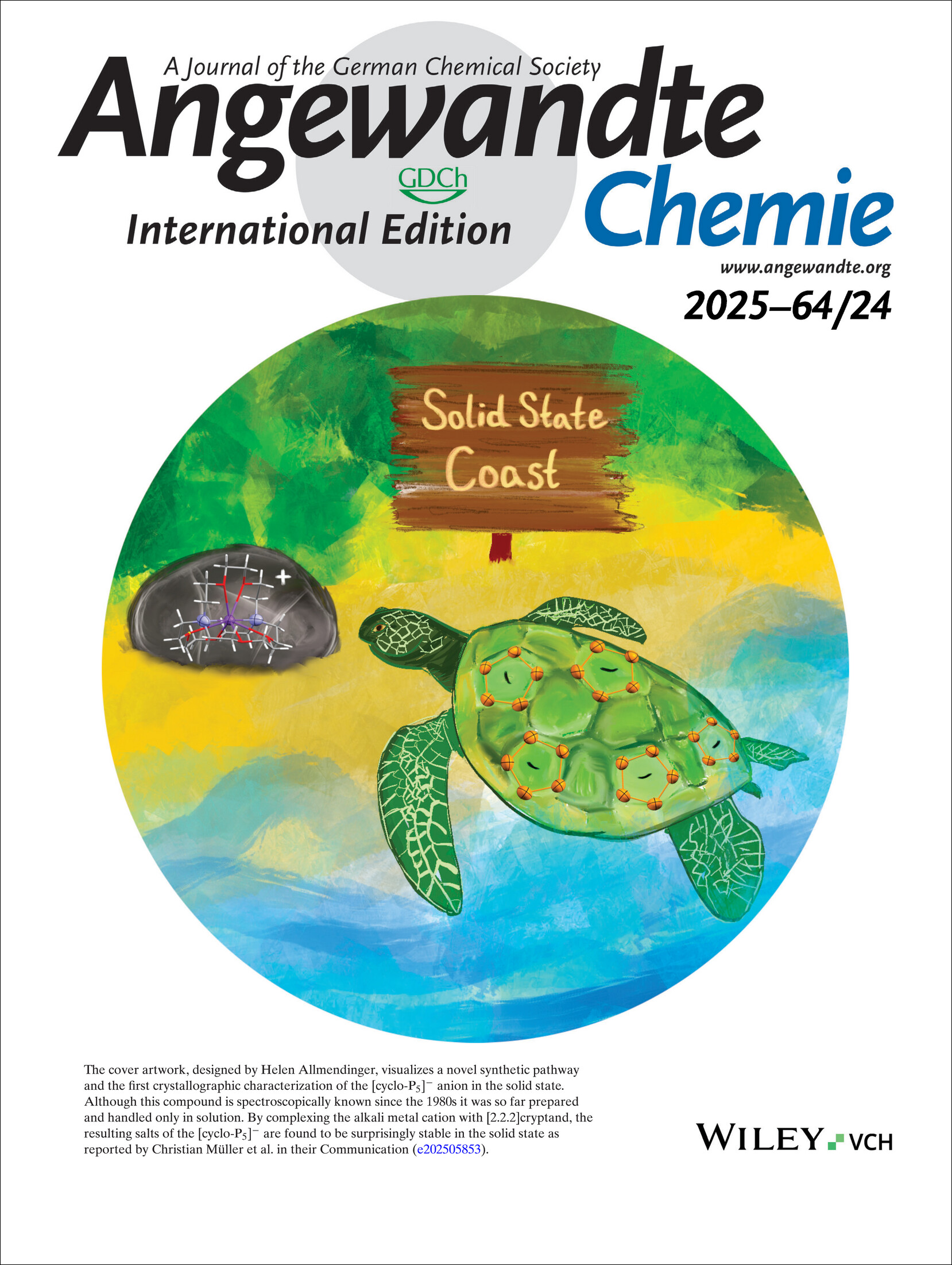
The cover artwork, designed by Helen Allmendinger, visualizes a novel synthetic pathway and the first crystallographic characterization of the [cyclo-P5]− anion in the solid state. Although this compound is spectroscopically known since the 1980s it was so far prepared and handled only in solution. By complexing the alkali metal cation with [2.2.2]cryptand, the resulting salts of the [cyclo-P5]− are found to be surprisingly stable in the solid state as reported by Christian Müller et al. in their Communication (e202505853).
Outside Back Cover: Data–Knowledge-Dual-Driven Electrolyte Design for Fast-Charging Lithium Ion Batteries (Angew. Chem. Int. Ed. 24/2025)
- First Published: 13 May 2025
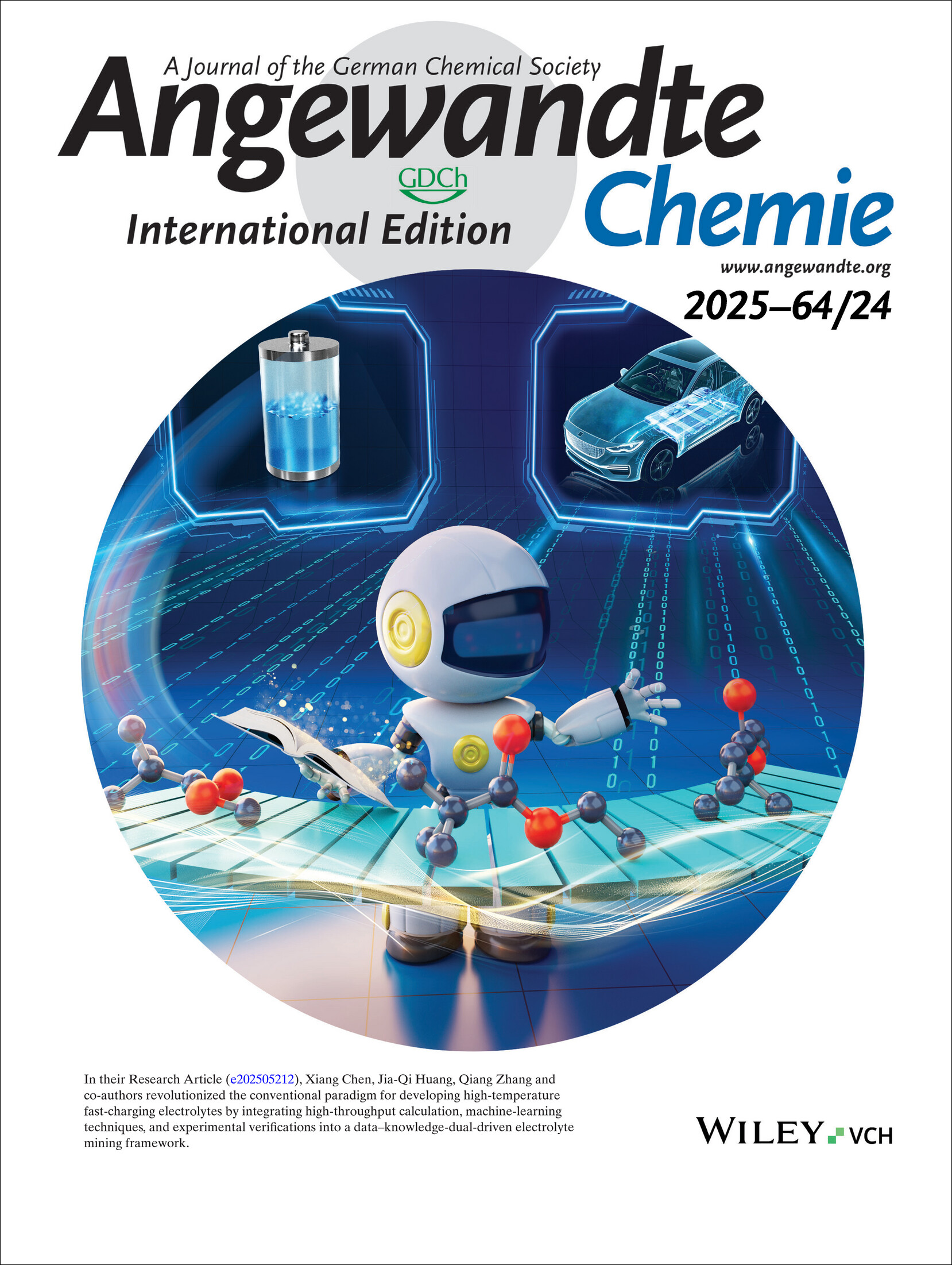
In their Research Article (e202505212), Xiang Chen, Jia-Qi Huang, Qiang Zhang and co-authors revolutionized the conventional paradigm for developing high-temperature fast-charging electrolytes by integrating high-throughput calculation, machine-learning techniques, and experimental verifications into a data–knowledge-dual-driven electrolyte mining framework.
Frontispiece
Frontispiece: Self-Optimized Reconstruction of Metal–Organic Frameworks Introduces Cation Vacancies for Selective Electrosynthesis of Hydrogen Peroxide
- First Published: 07 June 2025
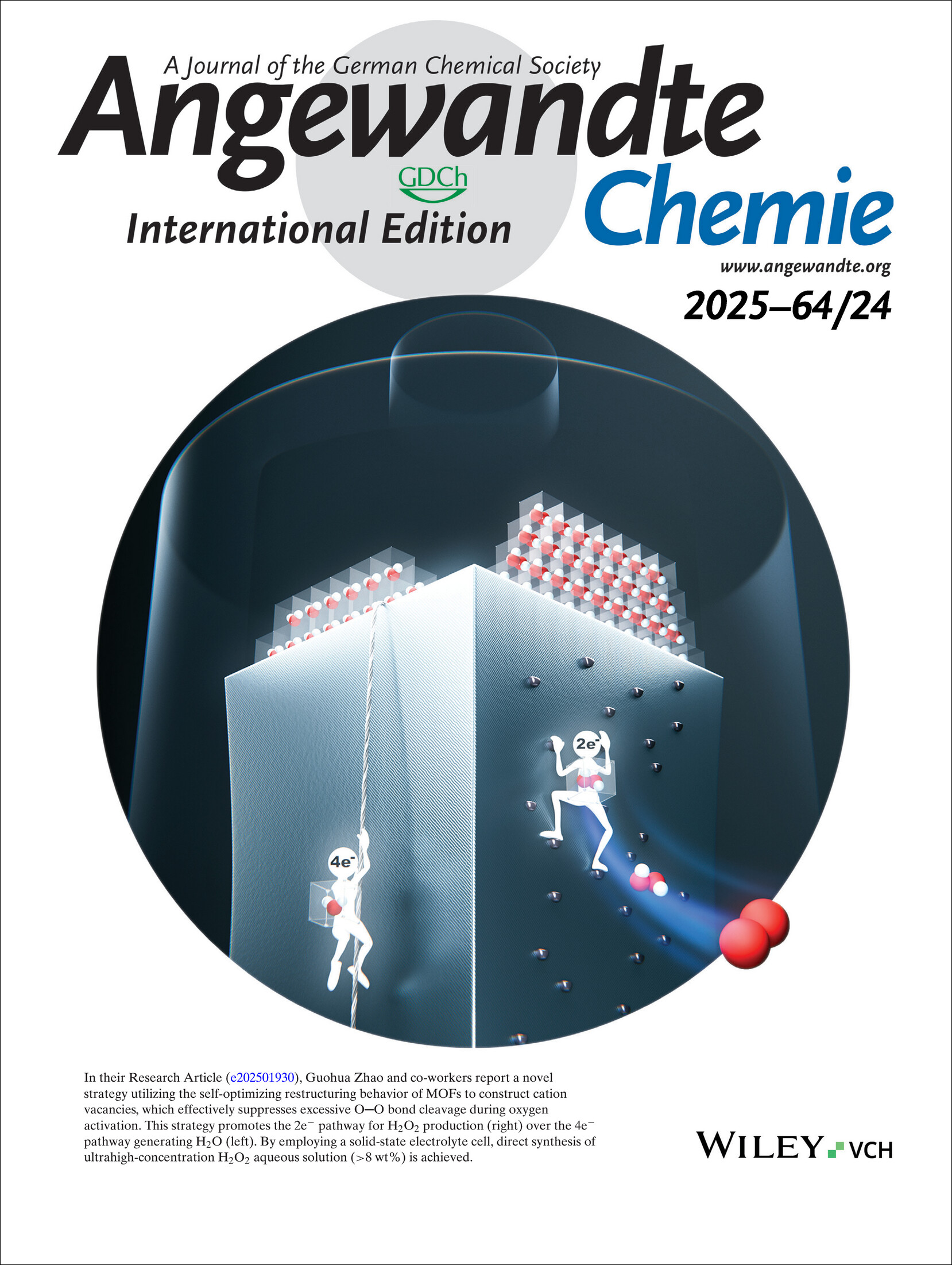
In their Research Article (e202501930), Guohua Zhao and co-workers report a novel strategy utilizing the self-optimizing restructuring behavior of MOFs to construct cation vacancies, which effectively suppresses excessive O─O bond cleavage during oxygen activation. This strategy promotes the 2e− pathway for H2O2 production (right) over the 4e− pathway generating H2O (left). By employing a solid-state electrolyte cell, direct synthesis of ultrahigh-concentration H2O2 aqueous solution (>8 wt%) is achieved.
Introducing …
Introducing…
Gang Li
- First Published: 02 May 2025

“The best way to organize lab jobs is to encourage the students to discuss and coordinate among themselves rather than micromanaging the process… The book currently on my bedside table is How to Talk to Your Cat: Get Inside the Mind of Your Pet by Claire Bessant…”
Find out more about Gang Li in his Introducing… Profile.
Scientific Perspective
Magnetically Induced Catalysis
Magnetically Induced Catalysis: Definition, Advances, and Potential
- First Published: 18 April 2025

In this scientific perspective, we intend to provide a coherent framework for the field of magnetocatalysis by highlighting opportunities associated with the use of magnetic fields to activate catalysts. A particular focus will be placed on magnetically induced catalysis, providing an overview on current advances and identifying scientific and technical challenges on the path toward a widespread use of this technology in research and industry.
Minireview
Bioisosteres
Catalytic Asymmetric Synthesis of Chiral Caged Hydrocarbons as Arenes Bioisosteres
- First Published: 11 April 2025
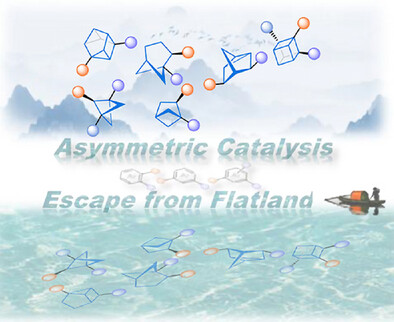
Chirality plays a crucial role in the biological interactions, safety, and effectiveness of drugs. The increasing use of caged hydrocarbons as bioisosteres for planar benzene moieties in drug design has heightened the need for asymmetric catalysis strategies to produce chiral caged molecules. This minireview showcases recent progress in this rapidly growing research field.
Biomaterials
Review
Hydrogels
Interfacial Chemistry in Functional Hydrogel Coatings
- First Published: 27 March 2025
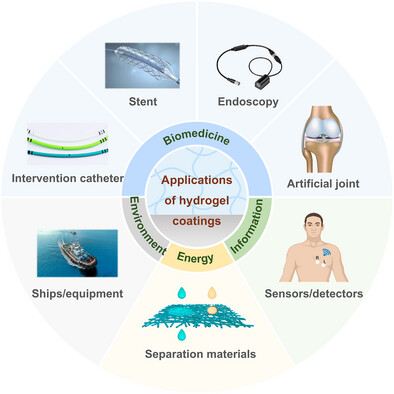
In this comprehensive overview of research progress in functional hydrogel coatings, the interfacial mechanisms between hydrogel coatings and substrates are discussed, and the preparation methods with their respective advantages and disadvantages for hydrogel coatings are summarized. Finally, the challenges in terms of large-scale preparation, long-term stability, and multifunctionality are outlined, and a glimpse into future opportunities is offered.
Nanoreactors
Supramolecular Gels as Active Tools for Reaction Engineering
- First Published: 28 March 2025

The unique combination of environments within gels, self-assembled from low-molecular-weight gelators, offers the ability to control reactivity in new ways, achieving unique reaction outcomes, leading to the emerging concept of supramolecular gels as nanoreactors. Smart chemical engineering methods enable the use of such gels to fabricate materials and devices potentially capable of transforming the way synthesis is done.
Photoswitches
Manipulation of Chemistry and Biology with Visible Light Using Tetra-ortho-Substituted Azobenzenes and Azonium Ions
- First Published: 28 March 2025
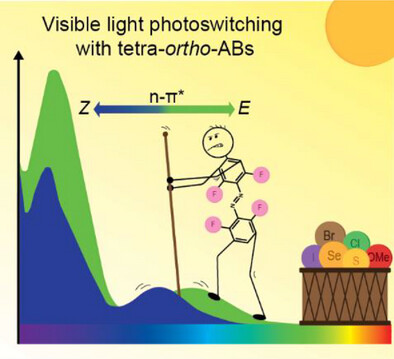
Tetra-ortho-Azobenzenes (TOABs) in broad daylight: in recent years, TOAB photoswitches became indispensable tools for all-visible-light manipulation of chemistry, biology and materials. This review explores their unique photochemical properties, design and synthetic approaches, offering support in choosing a TOAB for a given application.
Research Article
H2O2 Production
Self-Optimized Reconstruction of Metal–Organic Frameworks Introduces Cation Vacancies for Selective Electrosynthesis of Hydrogen Peroxide
- First Published: 01 April 2025
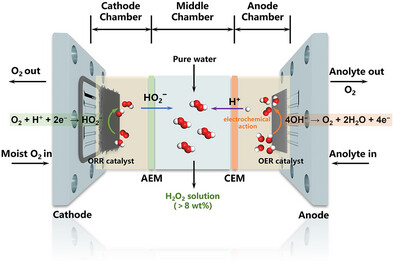
Cation vacancy engineering was employed to tune the electronic and surface structures of the materials, thereby inhibiting further O─O bond breakage, which leads to excellent 2e− oxygen reduction reaction (ORR) performance under industrial current density for continuous output of ultra-high H2O2 concentrations in excess of 8 wt%. This work is expected to provide illuminating insights for the development of efficient 2e− ORR electrocatalysts.
Organometallics
A Bench-Stable Fluorophosphine Nickel(0) Complex and Its Catalytic Application
- First Published: 09 April 2025
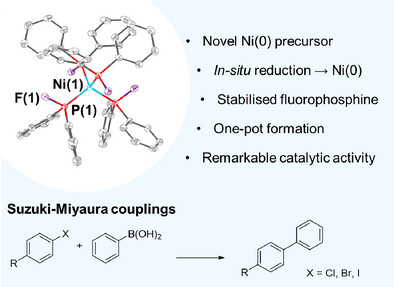
We herein present the synthesis of a bench-stable Ni(0) complex, [Ni(PFPh2)4], stabilized by vastly underexplored fluorophosphine ligands. The application of [Ni(PFPh2)4] in Suzuki–Miyaura and Kumada-Tamao-Corriu cross-coupling reactions as well as in Buchwald–Hartwig C─N bond formation reactions, indicates its promising potential as alternative to conventional Ni(0) sources.
CO2 Reduction
Optimizing the Selectivity of CH4 Electrosynthesis from CO2 Over Cuprates Through Cu─O Bond Length Descriptor
- First Published: 07 April 2025
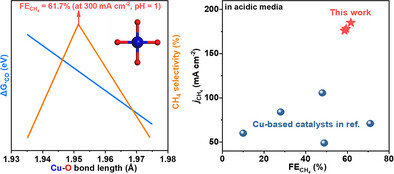
A selectivity descriptor based on Cu─O bond length was established to screen highly selective cuprates toward CH4 electrosynthesis. This descriptor revealed that CH4 selectivity exhibited a volcano-shaped correlation with the Cu─O bond length, with the optimal value accessible at ∼1.951 Å. Using this descriptor, three new cuprates were predicted, demonstrating better performance compared to the reported Cu-based catalysts in acidic electrolytes.
Batteries
Data–Knowledge-Dual-Driven Electrolyte Design for Fast-Charging Lithium Ion Batteries
- First Published: 07 April 2025
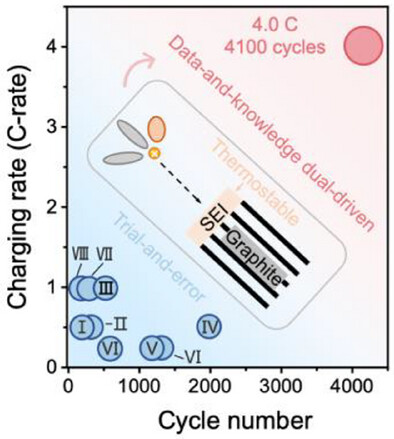
A data–knowledge-dual-driven framework is proposed for mining high-temperature fast-charging electrolytes, integrating high-throughput calculation, machine learning, and experimental verification. The screened ethyl trimethylacetate-based electrolyte strengthens Li-ion batteries performance at 4.0 C and 45 °C by thermostable solid-electrolyte-interphase.
DNA Nanotechnology
DNA Framework-Ensembled Aptamers Enhance Fluid Stability in Circulating Tumor Cells Capture for Tumor Treatment Evaluation
- First Published: 05 March 2025

We develop a tetrahedral DNA framework (TDF) engineered multivalent aptamers (TEAn) with programmable ligands size and configuration, enabling high-efficiency capture of CTCs and accurate monitoring of clinical treatment progress. The precisely structured TEAn ensures the size-matching and cooperative hybridization with epithelial cell adhesion molecule (EpCAM) clusters on cell membrane.
Sustainable Polymer Chemistry
Functionalized Cyclic Poly(α-Hydroxy Acids) via Controlled Ring-Opening Polymerization of O-Carboxyanhydrides
- First Published: 07 April 2025

A novel catalytic system consisting of a lanthanum complex with a sterically bulky ligand and a manganese silylamide has been developed to prepare high-molecular-weight (>100 kDa) stereoregular cyclic polyesters and block copolyesters with narrow molecular weight distributions (Ɖ < 1.1) and unique physical properties.
Inorganic Materials | Very Important Paper
A Capping-assisted Strategy for Synthesis of Glass-like Carboxylate-based Coordination Polymers
- First Published: 03 April 2025
Radical Reactions
Alcohol Activation by Benzodithiolylium for Deoxygenative Alkylation Driven by Photocatalytic Energy Transfer
- First Published: 03 April 2025
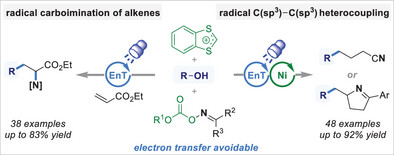
1,3-Benzodithiolylium cation was identified as an alcohol-activating reagent for energy-transfer-driven deoxygenative radical alkylation, avoiding electron transfer. Photocatalytic deoxygenative coupling reactions of alcohols with diverse oxime carbonates involving selective C(sp3)─C(sp3) bond construction are presented, including energy-transfer-driven carboimination of alkenes, energy transfer (EnT)/nickel dual-catalyzed ring-opening cross-coupling, and cyclization cross-coupling.
Photopharmacology
Synthesis and Characterization of Photoswitchable Covalent Ligands for the β2-Adrenoceptor
- First Published: 07 April 2025
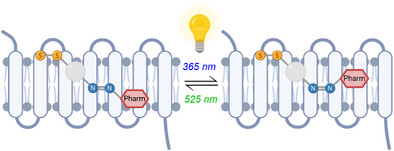
A structure-based design of a covalent photoswitchable ligand for the β2-adrenergic receptor, a therapeutically relevant GPCR, is described. This tool facilitates the modification of the intrinsic activity of the protein by light. Computational analysis of its mechanism of action suggests that the photoswitch takes place within the binding pocket.
Organic Solar Cells | Very Important Paper
Acridine-Substituted-Centronucleus Nonfullerene Acceptors Enables Organic Solar Cells with Over 20% Efficiency with Low Nonradiative Recombination Loss
- First Published: 03 April 2025
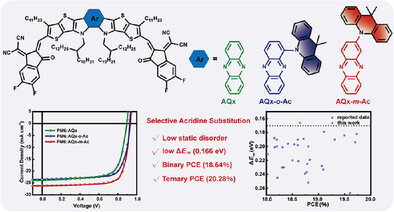
Three small-molecule acceptors, AQx, AQx-o-Ac, and AQx-m-Ac, were designed and synthesized, differing in their acridine substitutions. AQx-m-Ac demonstrates minimal static disorder, reduced nonradiative energy loss, and enhanced crystallization, culminating in a PCE of 18.64% in PM6:AQx-m-Ac OSCs. Incorporating AQx-m-Ac as a third component into the PM6:eC9 blend elevated the PCE of the optimal ternary system to 20.28%.
Covalent Organic Frameworks | Hot Paper
Oligoether Chain Engineering in Covalent Organic Frameworks: Enhancing Transport Pathways and Oxygen Reduction Activity for Efficient Electrocatalytic Hydrogen Peroxide Production
- First Published: 03 April 2025
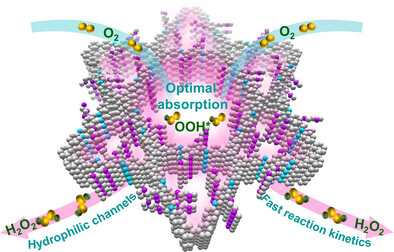
Oligoether chain engineering in covalent organic frameworks with hydrophilic ethylene oxide-based structures enhances mass diffusion and facilitates the formation of OOH* intermediate in the oxygen reduction reaction, leading to accelerated reaction kinetics and high selectivity for the two-electron pathway in hydrogen peroxide production.
Peptides
Decoding the Chemical Language of Ribosomally Synthesized and Post-Translationally Modified Peptides from the Untapped Archaea Domain
- First Published: 03 April 2025

Secondary metabolites (SMs) are essential across all life domains, yet those originating from the Archaea domain remain poorly understood. Here, the systematic genome mining and the pioneering heterologous expression of archaeal SMs have revealed the chemical landscape of archaeal lanthipeptides, showing both canonical and non-canonical forms. These lanthipeptides exhibit antagonistic activity and activate the host's motility, likely shaping the archaeal community and mediating environmental adaptation.
Asymmetric Catalysis
Rhodium-Catalyzed Atroposelective Synthesis of Axially Chiral 1-Aryl Isoquinolines via De Novo Isoquinoline Formation
- First Published: 03 April 2025

A highly efficient synthesis of axially chiral 1-aryl isoquinolines through rhodium-catalyzed C─H activation/annulation of aromatic imines with alkynes is reported. An enantioselective de novo isoquinoline ring formation is involved in this process. Detailed experimental and theoretical studies revealed the turnover-limiting step of the reaction and the origin of enantioselectivity.
Birefringent Materials
A 3D Hybrid Perovskite Ferroelastic with Triclinic-to-Cubic Phase Transition Boosts Temperature/Pressure Dual On/Off Switchable Birefringence
- First Published: 03 April 2025
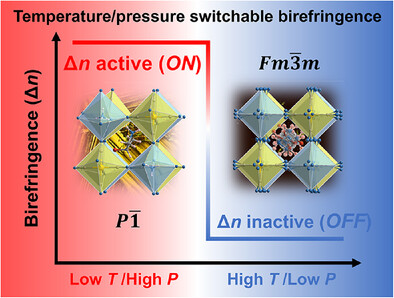
A 3D hybrid perovskite ferroelastic shows both temperature- and pressure-triggered phase transitions at 296 K and critical pressure of 0.3 GPa, which enables the temperature/pressure dual stimuli induced on/off switching of birefringence between birefringence-active state in anisotropic ferroelastic phase and birefringence-inactive state in isotropic paraelastic phase. Such a dual-stimuli switchable birefringence is unprecedented.
Biosynthesis
Discovery and Biosynthesis of Celluxanthenes, Antibacterial Arylpolyene Alkaloids From Diverse Cellulose-Degrading Anaerobic Bacteria
- First Published: 03 April 2025
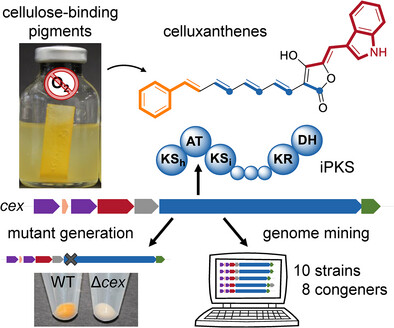
The structure and biosynthetic origin of the enigmatic “yellow affinity substance” (YAS) from the anaerobe thermophile Clostridium thermocellum (now: Acetivibrio thermocellus) were elucidated. YAS is a complex of unusual antibacterial arylpolyene alkaloids (celluxanthenes) that are produced by various cellulolytic anaerobes.
Tumor Theranostic
Spherical Nucleic Acids-Directed Cryosynthesis of Manganese Nanoagents for Tumor Imaging and Therapy
- First Published: 03 April 2025
Hydrogen Evolution
Vacancy and Dopant Co-Constructed Active Microregion in Ru–MoO3−x/Mo2AlB2 for Enhanced Acidic Hydrogen Evolution
- First Published: 03 April 2025

A novel Ru-doped low crystalline-crystalline MoO3−x/Mo2AlB2 hybrid material was designed. The region containing Ru atom and/or O vacancy is innovatively defined as the active microregion. The Ru─O─Mo bonds with shorter bond lengths provide satisfactory preconditions for the electronic structure modulation of O atoms. The ∆GH* of electron-rich O atoms is close to 0, which can effectively enhance the catalytic activity of HER.
Homogeneous Catalysis | Very Important Paper
Ligand-Controlled Regiodivergent Carbosilylation of 1,3-Dienes via Nickel-Catalyzed Three-Component Coupling Reactions
- First Published: 03 April 2025

A regiodivergent nickel-catalyzed carbosilylation of 1,3-dienes using aldehydes and silylboranes has been developed, with ligand control influencing the reaction pathway. The employment of triethylphosphine promotes 4,3-addition selectivity, whereas using (2-biphenyl)dicyclohexylphosphine leads to 4,1-addition selectivity.
CO2 Reduction
Cathodic Hydroxide Ions Induce Tetrose Formation during Glycolaldehyde Electroreduction to Alcohols: A Potential CO2-to-Carbohydrate Pathway
- First Published: 03 April 2025
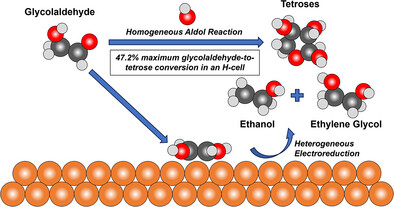
The glycolaldehyde electrolysis mechanism to alcohols and tetroses is comprehensively studied. Novel insights on the role of glycolaldehyde in the late stages of the overall CO2 reduction reaction pathways to ethanol and ethylene glycol on copper are presented. We demonstrate for the first time that C4 sugars (47.2% maximum conversion) can be produced in the electrochemical cell under ambient conditions due to the hydroxide ions produced on the cathode.
ORR Catalysts
Unveiling the Catalytic Potential of Facet Heterojunctions in Platinum Alloys for Oxygen Reduction Reaction
- First Published: 03 April 2025
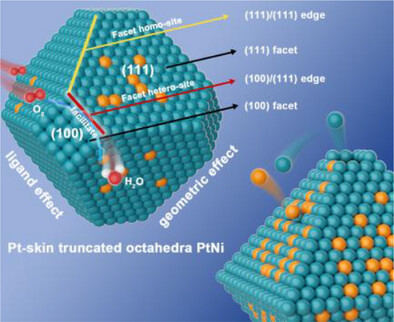
The transition of octahedral PtNi nanoparticles (NPs) to a truncated structure enriches the diversity of catalytic sites. The edge sites, featuring facet heterojunctions, leverage geometric and ligand synergies to enhance the oxygen reduction reaction (ORR) and optimize the adsorption of oxygenated intermediates, leading to superior performance in proton exchange membrane fuel cells (PEMFCs).
Siderophores | Hot Paper
Antibacterial Siderophores of Pandoraea Pathogens and Their Impact on the Diseased Lung Microbiota
- First Published: 03 April 2025
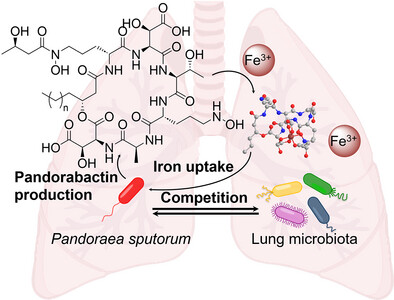
Genome mining of environmental and pathogenic Pandoraea species identified a conserved NRPS gene cluster and led to the discovery of novel siderophores, pandorabactins, which exert their antibacterial activity by depleting iron from competitors. Bioinformatic analysis of sputum from cystic fibrosis patients coupled with bioassays indicates that pandorabactins outcompete other bacteria in sequestering iron and have an impact on the diseased lung microbiota.
Homogeneous Catalysis
Bis(pinacolato)Diboron-Enabled Nickel-Catalyzed Regio- and Enantioselective Reductive [3 + 2] Annulation of β-Bromoenones with Alkynes
- First Published: 07 April 2025
![Bis(pinacolato)Diboron-Enabled Nickel-Catalyzed Regio- and Enantioselective Reductive [3 + 2] Annulation of β-Bromoenones with Alkynes](/cms/asset/2a4a96fe-6a26-4263-b58a-2631ca6f3ddc/anie202506873-gra-0001-m.jpg)
We report the first bis(pinacolato)diboron-enabled Ni-catalyzed regio- and enantioselective reductive [3 + 2] annulation of β-bromoenones with alkynes, providing convenient access to synthetically valuable chiral five-membered cyclic tertiary alcohols via axial chirality transfer to central chirality. A broad substrate scope, late-stage functionalization of complex molecules, and diverse transformations highlight the utility of this reaction.
Fluorescent Probes
A Photoactivatable Plasma Membrane Probe Based on a Self-Triggered Photooxidation Cascade for Live Cell Super-Resolution Microscopy
- First Published: 07 April 2025
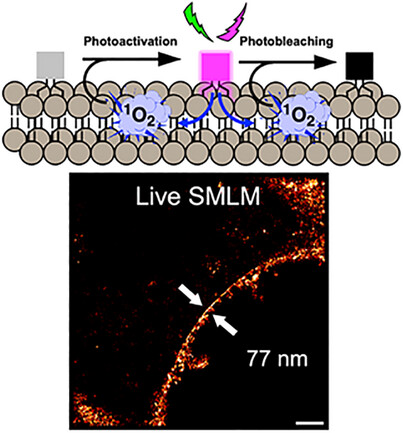
Herein, we establish a new photoswitching concept called self-triggered photooxidation cascade (STPC). Rhodamine dyes have mild photosensitizing properties that enable subsequent photoactivation and photobleaching of a leuco-rhodamine plasma membrane probe. Upon laser irradiation in the visible range, we successfully performed live SMLM (Single-molecule localization microscopy), allowing to image the plasma membrane at the nanoscale.
Photocatalysis
Application of Molecular Ferroelectric in Photocatalytic Selective Oxidization of C(sp3)─H Bonds
- First Published: 07 April 2025
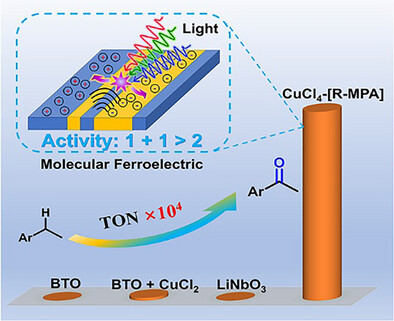
The molecular ferroelectric CuCl4-[R-MPA] (MPA = β-methylphenethylamine) achieves a remarkable 104-fold enhancement in alkane oxidation activity compared to BaTiO3, with a turnover number (TON) of 6286 under light and ultrasound. Its built-in electric field enables efficient charge separation, while synergistic effects drive reactive oxygen species generation, highlighting its promising application in photocatalysis.
Supramolecular Chemistry
Redox-Controlled, Sequential Self-Sorting of Supramolecular Assemblies in Model Protocells
- First Published: 07 April 2025
Flexible Perovskite Solar Cells | Hot Paper
Enhancing Efficiency and Stability of Inverted Flexible Perovskite Solar Cells via Multi-Functionalized Molecular Design
- First Published: 07 April 2025
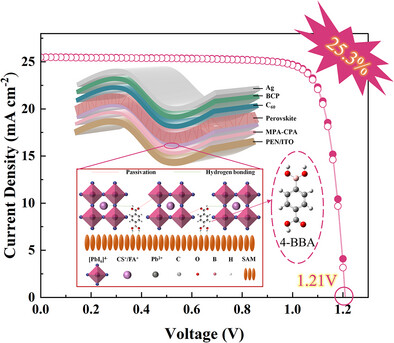
We specifically introduced a 4-BBA molecule into the perovskite film to form a multifunctional bridging structure anchored with the SAM layer, which passivated Pb2+ ion defects and regulated crystallization of the perovskite film, enhancing interfacial contact and releasing residual strain. The resultant f-PSCs achieved a high PCE of 25.30% (25.13% certified) with a record VOC of 1.21 V.
In Vivo Electrochemistry
Aptamer-Based Galvanic Potentiometric Sensor for Real-Time Monitoring of Serotonin Signaling Under Psychosocial Stress
- First Published: 04 April 2025
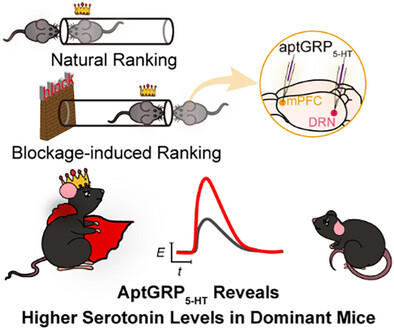
A phosphorothioate aptamer-based galvanic redox potentiometric sensor (aptGRP5-HT) with enhanced sensitivity and selectivity enables real-time monitoring of serotonin in a mouse model of psychosocial stress. It reveals, for the first time, a distinct correlation between serotonin release and social hierarchy, with higher serotonin levels in dominant mice.
Reductive Catalytic Fractionation of Lignocellulose | Hot Paper
Reductive Catalytic Fractionation of Lignocellulose Toward Propyl- or Propenyl-Substituted Monomers and Mechanistic Understanding
- First Published: 07 April 2025
Methane Oxidation | Very Important Paper
A Novel Tandem Reaction System for High-Concentration Acetic Acid Production from Methane and Oxygen
- First Published: 07 April 2025
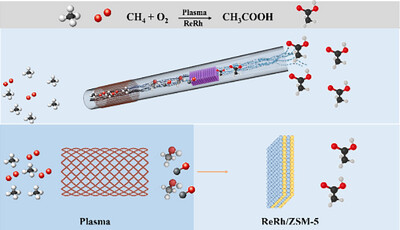
This study developed a plasma-thermo-catalytic tandem system, optimizing plasma processes in a self-designed reactor to achieve 68.0% methane conversion and 5.2 mol L−1 methanol concentration. A hydrophobic ReRh/ZSM-5-S catalyst minimized byproduct effects, enabling 52.0% acetic acid selectivity and 1.3 mol L−1 concentration, three orders of magnitude higher than traditional methods, meeting industrial criteria and advancing efficient methane utilization.
CO2 Reduction
Plastic from CO2, Water, and Electricity: Tandem Electrochemical CO2 Reduction and Thermochemical Ethylene-CO Copolymerization
- First Published: 07 April 2025

A new system of generating entirely CO2-generated abiotic polymers by integrating electrochemical CO2 reduction (eCO2R) and organometallic polymerization catalysis is presented, having an overall CO2-to-polymer conversion of 14% and current-to-polymer efficiency of 51%. A strategy for tuning the product composition obtained from eCO2R by combining different electrocatalysts is introduced. CO-ethylene copolymerization activity in the presence of potential poisons from eCO2R is retained.
Carbon Organic Frameworks
Cobalt-Metalated 1D Perylene Diimide Carbon-Organic Framework for Enhanced Photocatalytic α-C(sp3)─H Activation and CO2 Reduction
- First Published: 07 April 2025
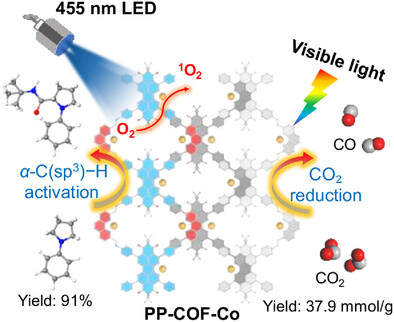
A one-dimensional ABC-stacking covalent organic framework (PP-COF), integrating perylene diimide (PDI) as a photosensitizer and 1,10-phenanthroline as a metal-coordination site, was synthesized. Post-synthetic cobalt metalation afforded PP-COF-Co, which enhanced single oxygen (1O2) generation and electron-hole pair separation, significantly boosting its photocatalytic performance in α-C(sp3)─H activation and CO2 reduction.
Iridium Catalysis
Synthesis of Chiral δ-Aminoboronic Esters by Enantioselective Hydrogenation of 1,2-Azaborines
- First Published: 07 April 2025
Photothermal Therapy | Very Important Paper
An Immediate Bacterial-Responsive Supramolecular Thio-Naphthalene Diimide: A Real-Time NIR-II Photothermal Anti-Bacterial
- First Published: 07 April 2025
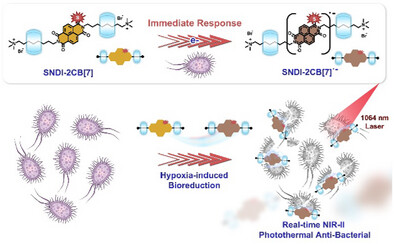
A supramolecular thio-naphthalene diimide can be immediately reduced to a supramolecular radical anion by bacteria, leading to a NIR-II absorption. This strategy effectively raises the reduction potential, thereby greatly boosting the reduction speed. This approach has been used as a real-time NIR-II photothermal anti-bacterial and opens new horizons for bio-responsive agents.
Selenium Solar Cells | Hot Paper
Photovoltaic Absorber “Glues” for Efficient Bifacial Selenium Photovoltaics
- First Published: 07 April 2025
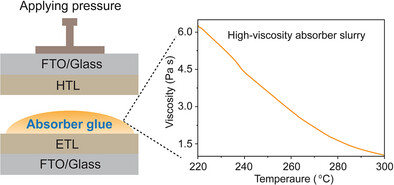
A glue-bonding strategy using high-viscosity molten selenium (Se) as an adhesive is reported to bond two fluorine-doped tin oxide (FTO) glasses, creating bifacial solar cells without magnetron sputtering. The Se cells exhibit a bifaciality factor of 90.1%, with efficiencies of 8.61% under 1-sun with an albedo of 0.3 and 26.17% under 1000-lux indoor illumination with an albedo of 0.8.
Photocatalysis | Hot Paper
Engineering Bodipy-Based Metal–Organic Frameworks for Efficient Full-Spectrum Photocatalysis in Amide Synthesis
- First Published: 07 April 2025
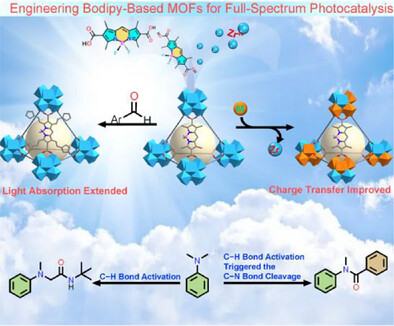
Three highly stable bodipy-based metal–organic frameworks (BMOFs) were synthesized by treating dicarboxyl-functionalized bodipy ligands with Zr-oxo clusters. Featuring the distinct bodipy scaffold in the framework, these BMOFs displayed high reactivity in heterogenous photocatalytic C─H bond activation of N,N-dimethylanilines to access amides under visible light.
Zinc-Ferricyanide Flow Batteries | Very Important Paper
Redox-Mediated Lithium Recovery From Spent LiFePO4 Stabilizes Ferricyanide Catholyte for Durable Zinc-Ferricyanide Flow Batteries
- First Published: 07 April 2025
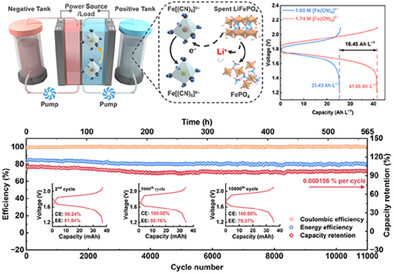
Redox-mediated lithium recovery from spent LiFePO4 batteries enables high-solubility catholytes (up to 1.74 M [Fe(CN)6]4⁻) for ultra-stable alkaline zinc-ferricyanide flow batteries. This dual-function strategy integrates sustainable lithium recycling with advanced energy storage, achieving enhanced cycling stability and energy density.
C─H Activation
Modification of [2.2]Paracyclophanes via Cobalt/Salox-Catalyzed Enantioselective Electrooxidative or Photoredox C─H Acyloxylation and Alkoxylation
- First Published: 07 April 2025
![Modification of [2.2]Paracyclophanes via Cobalt/Salox-Catalyzed Enantioselective Electrooxidative or Photoredox C─H Acyloxylation and Alkoxylation](/cms/asset/3c00d947-4e5f-44ec-a5a8-9e85d028f4aa/anie202506465-gra-0001-m.jpg)
An efficient protocol with an excellent s-factor for the preparation of chiral [2.2]paracyclophanes through cobalt-catalyzed enantioselective C─H oxygenation was developed. This approach leverages traceless electrons or oxygen to replace traditional stoichiometric metal oxidants, facilitating the reaction under mild conditions with broad scope.
Metal-Organic Cages
Development of an Automated Workflow for Screening the Assembly and Host–Guest Behavior of Metal-Organic Cages Towards Accelerated Discovery
- First Published: 07 April 2025

An automated experimental workflow to accelerate the discovery of metal-organic cages (MOCs), which is often hindered by slow, manual approaches, has been developed. Automation of the synthesis, characterization, and analysis, is supported by computational modelling to rationalize the experimental outcomes, and development of a host–guest assay elucidated trends in MOC binding behavior.
Chemical Protein Synthesis
Superfast Protein Desulfurization Triggered by Low-Energy Visible Light
- First Published: 07 April 2025
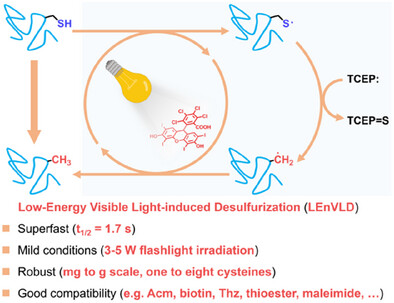
A practical strategy of low-energy visible light-induced desulfurization (LEnVLD) has been developed to enable superfast and clean desulfurization under exceptionally mild conditions. The utility of LEnVLD was demonstrated through the clean desulfurization of a wide range of peptide and protein substrates, and its convenience and robustness facilitated the application of LEnVLD in versatile reaction scenarios such as solid-supported desulfurization and flow chemistry-based desulfurization.
Zeolites | Very Important Paper
Structurally Engineering Multi-Shell Hollow Zeolite Single Crystals via Defect-Directed Oriented-Kinetics Transformation and Their Heterostructures for Hydrodeoxygenation Reaction
- First Published: 14 April 2025

A defect-directed oriented-kinetics transformation strategy is developed to prepare multi-shell hollow aluminosilicate ZSM-5 zeolite (MFI) crystals with single-crystalline feature, hierarchical macro-/mesoporosity, controllable shell number, and high structural stability. The resultant multi-shell hollow Ni-loaded ZSM-5 zeolite catalysts exhibit significantly enhanced catalytic activity in the hydrodeoxygenation of stearic acid into liquid fuels.
Systems Chemistry
Predator–Prey Behavior of Droplets Propelling Through Self-Generated Channels in Crystalline Surfactant Layers
- First Published: 08 April 2025
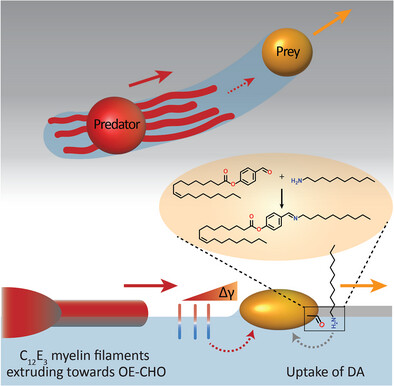
A crystalline layer is formed by an amphiphilic decylamine surfactant at the air/water interface. Aldehyde-containing ester oil droplets self-propel by consuming amines from the crystalline layer, thereby generating open channels along which myelin-forming amphiphile droplets chase and ultimately catch the aldehyde droplets in a predator–prey analogy.
Hybrid Halide
Mn(II)-Based Hybrid Halide Ionogel Scintillator Film for Large-Area and High-Resolution X-ray Imaging
- First Published: 07 April 2025
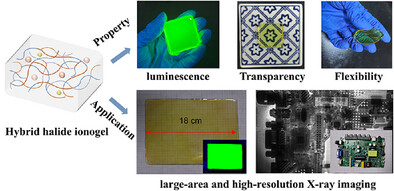
We propose a versatile approach for the rapid synthesis of luminescent Mn(II)-based hybrid halide ionogels (Mn-IG) by in situ forming zero-dimensional (0D) hybrid metal halides during monomer polymerization. The Mn─IG exhibits high transparency (with transmittance approaching 90% at 550–1100 nm) and uniform, high-efficiency emission. Leveraging its processability, we have fabricated an 18 cm × 12 cm scintillating film and successfully achieved large-area and high-resolution X-ray imaging. This simple and rapid synthesis method on ionogels paves the way for the low-process preparation of large-area scintillators and also opens up a new avenue for the in situ construction of uniform 0D halide-polymer composites.
Small Ring Systems
Nitrogen Insertion via Asymmetric Condensation and Chirality Transfer: A Stereodivergent Entry to Cyanocyclopropanes
- First Published: 08 April 2025

The synthesis of cyanocyclopropanes is achieved via asymmetric nitrogen insertion into prochiral cyclobutanones. Key mechanistic steps involve an organocatalyzed asymmetric condensation followed by chirality transfer via an intercepted Neber rearrangement. The reaction can be conducted in a one-pot, stereodivergent manner, allowing access to all possible cyclopropane isomers with precise control of stereochemistry.
Wiggling MOF
Hopping Diffusion in Wiggling Nanopore Architecture of MOF Enabling Synergistic Equilibrium-Kinetic Separation of Fluorinated Propylene and Propane
- First Published: 07 April 2025
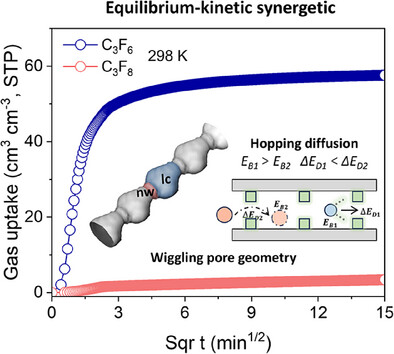
To address a critical challenge in electronic specialty gas (ESG) purification, we herein present a zirconium-based MOF with “wiggling pore geometry” featuring alternating narrow apertures and enlarged cavities. This architecture establishes an equilibrium-kinetic synergistic separation mechanism: narrow windows (nw) kinetically hinder C3F8 diffusion (DC3F6/DC3F8 ≈ 450), while F···H interactions in cavities thermodynamically favor C3F6 adsorption.
Electrocatalysis
A Powerful Regulator to Enhance Electrocatalytic Reaction Kinetics and Thermodynamics: The Ordered Hetero-Nanowire
- First Published: 07 April 2025
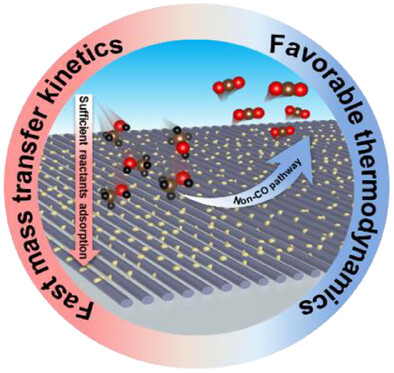
A novel ordered hetero-nanowire (NW) regulator is presented, which simultaneously couples the merits of the kinetics and thermodynamics in electrocatalysis. The periodical arrangement enables the formation of the local electric field to improve mass transfer kinetics, accounting for a significant boost in MOR performance. In addition, the hetero-NWs undergo the energetically favorable non-CO pathway, which is not susceptible to the invasion of toxic carbonaceous intermediates and thus ensures long-term durability for MOR.
Lewis Base Catalysis
N-(Acyldithio)Saccharin: Design, Synthesis and Applications in Catalytic Enantioselective Disulfuration/Amination of Alkenes
- First Published: 07 April 2025

N-(Acyldithio)saccharins are a novel class of highly electrophilic disulfurating reagents. Beyond enabling the disulfuration of diverse N-, S-, and Cnucleophiles, the reagents facilitate the catalytic enantioselective disulfuration/amination of unactivated alkenes. The resulting α-chiral disulfide products can be readily converted into various chiral sulfur-containing compounds.
DNA Circuits | Hot Paper
DNA-Based Signal Circuit for Self-Regulated Bidirectional Communication in Protocell-Living Cell Communities
- First Published: 07 April 2025
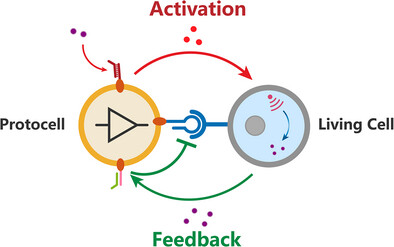
The intercellular communicating protocell with feedback loop was designed for self-regulating signal transmission in protocell/living cell community. This DNA-empowered protocell provides a bottom-up access route toward synthetic cellular systems with abilities for programming desired cellular behaviors.
Batteries
Entropy-Driven Competitive Adsorption Sites Tailoring Unlocks Efficient Hybrid Conversion Zn–Air Batteries
- First Published: 07 April 2025
Electrochemistry | Very Important Paper
Mechanistic Insights into the CO2-Assisted NO Electrochemical Deoxygenation and Hydrogenation
- First Published: 09 April 2025
Cancer Therapy
ATP-Assisted Electron and Proton Transfer Boosting Redox Metabolism-Induced Ferroptosis and Apoptosis for Cancer Therapy
- First Published: 09 April 2025

Vanadium and aurintricarboxylic coordination nanoparticles generate singlet oxygen and hydroxyl radicals specifically triggered by acidic H2O2 via dual-Russell reaction and Fenton-like reaction while depleting glutathione. Significantly, adenosine triphosphate induces VAP NPs aggregation, strengthens hydrogen-bonding network, and accelerates proton/electron transfer, thereby amplifying ROS level to co-activate ferroptosis and apoptosis.
Lithium Metal Batteries | Very Important Paper
Self-Compartmented Electrolyte Design for Stable Cycling of Lithium Metal Batteries under Extreme Conditions
- First Published: 07 April 2025
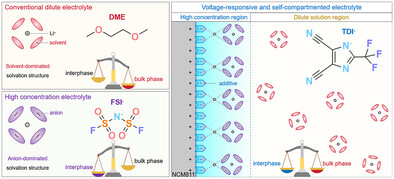
Self-compartmented electrolyte: A novel electrolyte concept utilizing LiTDI enables a high-concentration, anion-rich interfacial region and a low-concentration bulk electrolyte. This unique design simultaneously enhances interfacial stability and ion transport kinetics in high-voltage lithium-metal batteries.
Photoacoustic Imaging | Hot Paper
Switchable Closed-Shell and Open-Shell Biradical States in Bis-Palladium Complexes of Tetrathiadodecaphyrin via Coordination Rearrangement
- First Published: 08 April 2025

Bis-Pd(II) complexes of a figure-eight tetrathiadodecaphyrin, featuring different coordination modes (NNCS─Pd versus NNCC─Pd) and electronic states (closed-shell versus open-shell biradical), have been prepared. The two complexes exhibit noteworthy photoacoustic (PA) response to the first and second near-infrared (NIR-I/II) range, respectively, and are interconvertible through a one-electron redox involving a reversible metal coordination rearrangement.
Radical-Mediated Reduction of CO2 | Hot Paper
Ionized Water Facilitates the Sustainable Radical-Mediated Reduction of CO2 to Multi-Carbon Hydrocarbons and Oxygenates
- First Published: 07 April 2025
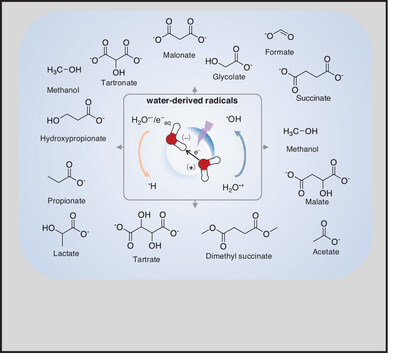
Ultraviolet (UV) irradiation of water generates radicals (H2O•+, •OH, e⁻aq, •H) that reduce CO2 to C1─C6 hydrocarbons and oxygenates. e⁻aq activates CO2 into CO2•⁻, while •H enables hydrogenation. Oxidative radicals recycle oxygenates back into CO2•⁻, sustaining a sustainable network. This process demonstrates ionized water as a reactive matrix for abiotic organic synthesis.
Seawater Electrolysis
Theory-Guided Design of Surface-Enhanced Ni–Mn Diatomic Site Catalysts for Efficient Seawater Electrolysis via the Degradation of High Ionization Potential Organic Pollutants
- First Published: 07 April 2025
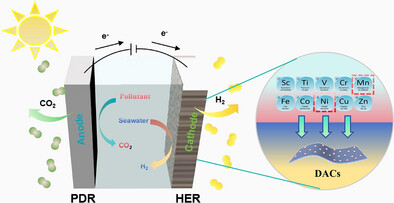
This study innovatively constructs a dual transition metal atoms catalytic system through the strategic anchoring of Ni and Mn atoms on oxygen-doped boron nitride (O-BN), achieving breakthrough performance in simultaneous high ionization potential pollutant degradation and hydrogen evolution for marine energy applications under light condition.
Cytosolic Delivery | Very Important Paper
DNA Nanotubule-Based Nanodevices with ATP-Responsive Gating for Direct Cytosolic Delivery of Nucleic Acids and Proteins
- First Published: 08 April 2025
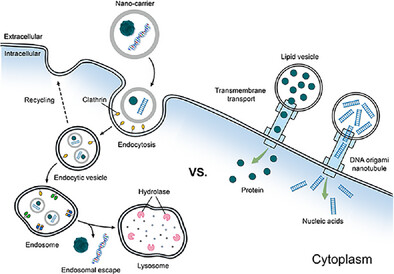
Schematic illustration of two pathways for macromolecular therapeutics delivery: nanoparticle-adopted endocytosis (left) and DNA nanotubule-mediated cytosolic delivery (right). By bypassing conventional endocytic routes, the nanotubules directly transport substantial payloads, including nucleic acids and proteins, across the plasma membrane.
Gas Separation
Electrostatic Potential Matching in an Anion-Pillared Framework for Benchmark Hexafluoroethane Purification from Ternary Mixture
- First Published: 08 April 2025
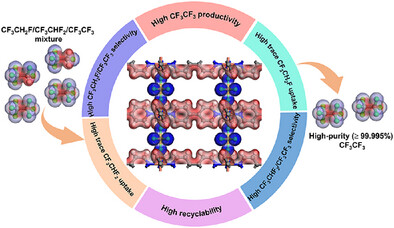
The electrostatic potential matching in the anion-pillared SIFSIX-1-Cu realizes effective anchoring of CF3CH2F and CF3CHF2 through multiple supramolecular interactions, exhibiting the highest CF3CH2F and CF3CHF2 adsorption capacity as well as unprecedented CF3CH2F/CF3CF3 and CF3CHF2/CF3CF3 selectivity, thereby achieving benchmark separation of ternary CF3CH2F/CF3CHF2/CF3CF3 mixture.
Hydrogen Peroxide Photosynthesis | Hot Paper
Building a Confluence Charge Transfer Pathway in COFs for Highly Efficient Photosynthesis of Hydrogen Peroxide from Water and Air
- First Published: 07 April 2025
Photocatalytic Metal Recovery
Decatungstate-Driven Photocatalytic Pathways for Sustainable and Cleaner Recovery of Precious Metals
- First Published: 07 April 2025
Main Group Chemistry | Very Important Paper
Crystalline Silagermenides as Powerful Synthons: Unraveling π-Bonding and Lone Pair Effects in the Multiple Bonds of Heavier Main Group Analogs of the Vinyl Anion
- First Published: 07 April 2025
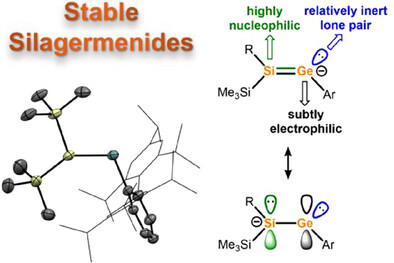
Acyclic silagermenides are synthesized through a straightforward desilylation process. Their electronic properties are explored using DFT calculations, revealing a high-lying and polarized Si─Ge π bond. Reactions with electrophiles lead to nucleophilic substitution at the Si atom, giving germylene intermediates, which then undergo further transformation into unique main group compounds and unprecedented metal complexes.
Nanographenes | Hot Paper
Synthesis and Characterization of Circumtetracene: Unraveling Structure-Property Relationships of Circumacenes
- First Published: 07 April 2025
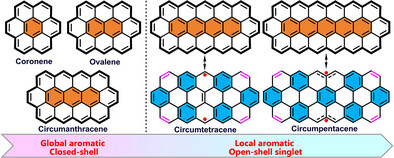
A stable circumtetracene derivative has been successfully synthesized and isolated in crystalline form. A comparison of its electronic properties (both experimentally and by theoretical calculations) with those of previously reported circumacene analogues, led to elucidation of a significant transition in the electronic structure from a closed-shell global aromatic to a singlet open-shell local aromatic configuration upon π-extension.
Solar-Driven Hydrogen Storage
Solar-Driven Reversible Hydrogen Storage of Sodium Cyclohexanolate/Phenoxide Pair
- First Published: 08 April 2025
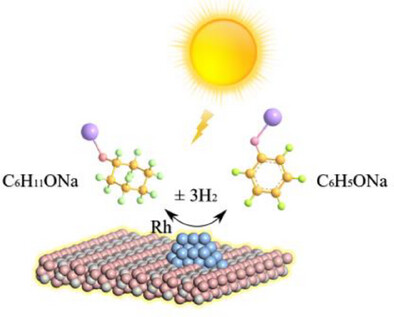
Solar-driven reversible hydrogen storage of sodium cyclohexanolate/phenoxide pair demonstrated 99.9% conversion and selectivity in both hydrogenation and dehydrogenation via photocatalysis without external heating. The synergy between high- and low-frequency light enhances the overall performance, i.e., low-frequency light provides heat, while high-frequency light facilitates the desorption of product from the catalyst surface.
Zn Batteries
Towards High-Performance Aqueous Zn-Organic Batteries via Using I−-Based Active Electrolyte
- First Published: 07 April 2025
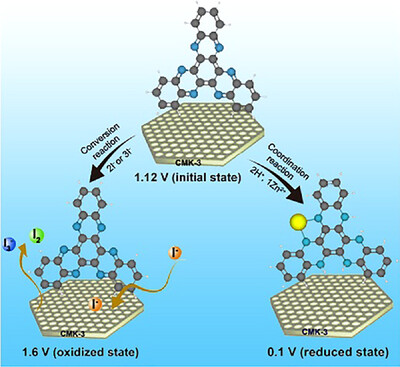
A high-performance Zn-organic battery (Zn//HATN@CMK-3 battery) is developed by using an I−-based active cathodic electrolyte. Benefiting from the high redox potential of the I−/I0 redox couple, the Zn//HATN@CMK-3 cell harvests a high average discharge voltage (0.75 V vs. Zn/Zn2+) and outstanding cycling stability at a high mass-loading (10 mg cm−2).
Cooperative Catalysis
Acyclic Quaternary Stereocenters via Catalytic Asymmetric Cross-Couplings with Unactivated Alkyl N-Hydroxyphthalimide Esters
- First Published: 07 April 2025
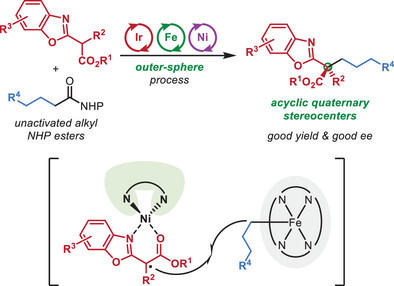
Enantioselective synthesis of compounds featuring an acyclic quaternary stereocenter was achieved through an iron-catalyzed alkylation reaction using unactivated alkyl N-hydroxyphthalimide (NHP) esters. The efficiency of this sterically demanding construction is dictated by an outer-sphere C─C bond formation mechanism, with enantioselectivity regulated by a cooperative triple catalysis system that integrates photoredox, chiral Lewis acid, and iron catalysis.
G-Quadruplex
Beyond Structure: Methylation Fine-Tunes Stability and Folding Kinetics of bcl2Mid G-Quadruplex
- First Published: 07 April 2025
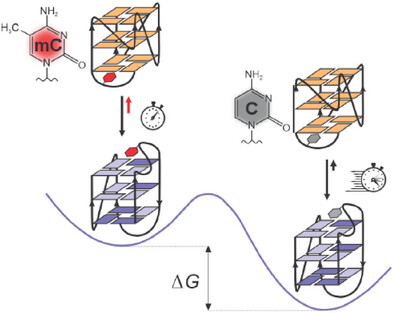
The introduction of a single 5-methylcytosine into a G-rich sequence originating from the B-cell lymphoma 2 (BCL2) gene promoter affects both the folding kinetics and thermodynamics of the two G4 structures and thus plays a crucial role in regulating G4 folding pathways, which has significant implications for the control of gene expression.
Covalent Organic Framework | Very Important Paper
High-Efficiency Ion Transport in Ultrathin 3D Covalent Organic Framework Nanofluidics
- First Published: 08 April 2025
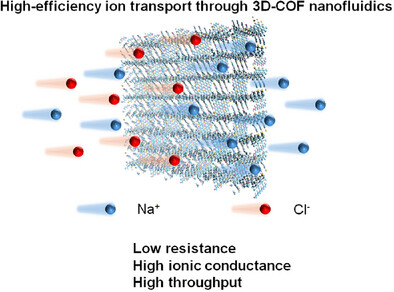
This work well manipulates the ion transport in nanoconfined channels by employing 3D covalent organic frameworks (3D-COFs). Owing to their continuously interpenetrated pathways and well-ordered pore arrangements, 3D-COF nanofluidics demonstrated high ionic flux and cation selectivity. Toward osmotic energy applications, 3D-COF nanofluidics output an ultrahigh power density of 1238.2 W m−2 under a 500-fold salinity gradient.
Organic Solar Cells | Hot Paper
Efficient Semitransparent Organic Solar Modules with Exceptional Diurnal Stability Through Asymmetric Interaction Induced by Symmetric Molecular Structure
- First Published: 09 April 2025

The symmetric molecular structure of 4FY has been shown to induce an “asymmetric molecular interaction”, which promotes a higher degree of molecular packing than in Y6. The asymmetry-driven molecular interactions can be leveraged to fabricate large-area semitransparent organic solar modules that are efficient and stable under realistic operating conditions.
DNA Nanotechnology
Selective Leaflet-Anchored DNA Nanoprobes for Simultaneous Monitoring of Juxta-Plasma Membrane Environments
- First Published: 08 April 2025
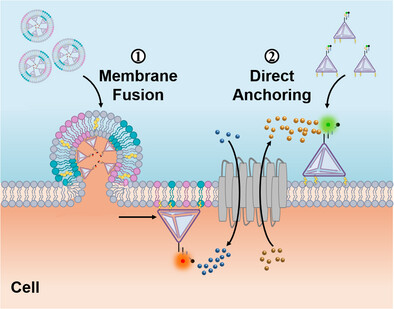
Fusogenic nanoliposomes were developed to effectively anchor amphiphilic DNA tetrahedral probes onto the inner leaflet of the cell membrane. By combining this strategy with the direct anchoring of amphiphilic probes on the outer leaflet, precise functionalization of both membrane leaflets could be achieved, thereby enabling simultaneous monitoring of both the inner and outer juxta-plasma membrane environments.
Covalent Organic Frameworks
Design and Construction of D-A-Extended 3D Covalent–Organic Frameworks for Boosting Photocatalytic Hydrogen Evolution
- First Published: 07 April 2025
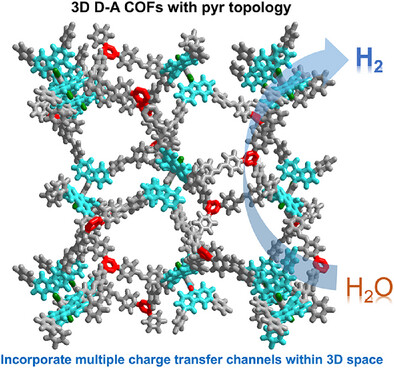
This study successfully developed three distinct 3D extended D-A COFs with a pyr topology by employing a newly designed intrinsic D-A type building block. Among these, the A-D-A structured COF stands out due to its multiple charge transfer channels in 3D space, resulting in an enhanced photocatalytic hydrogen evolution rate. This finding provides valuable insights into designing extended D-A constructs within 3D frameworks to optimize photocatalytic performance.
Aqueous Zinc Ion Batteries
Interfacial H-bond Network/Concentration Fields/Electric Fields Regulation Achieved by D-Valine Anions Realizes the Highly Efficient Aqueous Zinc Ion Batteries
- First Published: 09 April 2025
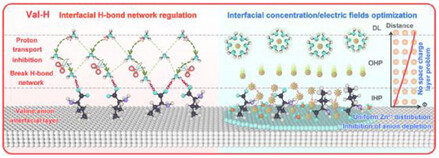
A D-valine anion interfacial layer reversely regulates the interfacial H-bond network and the interfacial concentration/electric fields, which realizes the synchronous occurrence of inhibition (suppressing H+ migration by disrupting the interfacial H-bond interaction and restraining the anion depletion layer formation) and optimization effects (homogenizing the interfacial Zn2+ flow and electric field).
Organic Solar Cells | Hot Paper
Regiospecific Halogenation Modulates Molecular Dipoles in Self-Assembled Monolayers for High-Performance Organic Solar Cells
- First Published: 09 April 2025
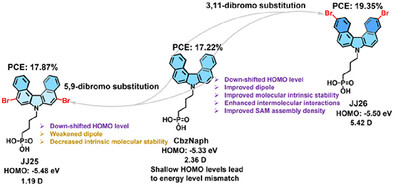
Herein, through regiospecific bromination on a helical 7H-dibenzo[c,g]carbazole-based SAM (CbzNaph) featuring a stronger dipole, we study the properties related to intrinsic stability, electrostatic potential (ESP) distribution, and changes in the molecular dipole of the derived SAM molecules. Bromination at the chemically inert sites of 7H-dibenzo[c,g]carbazole (JJ26) helps maximize molecular dipole while maintaining superior intrinsic stability. Together with the dense assembly promoted by enhanced intermolecular interactions and synergistic effects of stronger crystallinity, JJ26 efficiently modulates the work function (WF) of indium tin oxide (ITO) and enhances the stability of SAM under external pressure. The OSC device adopting JJ26 demonstrates significantly improved performance, achieving an efficiency of 19.35% along with notably enhanced stability.
Electrochemical Dehydrogenation
High-Throughput DFT-Assisted Design of Electrode for Efficient High-Temperature Electrochemical Dehydrogenation
- First Published: 08 April 2025
Electrocatalysis
Highly Selective Oxygen Electroreduction to Hydrogen Peroxide on Sulfur-Doped Mesoporous Carbon
- First Published: 09 April 2025
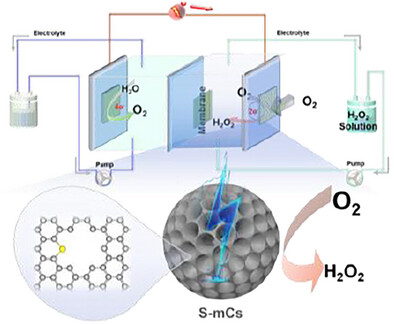
Vertically aligned sulfur-doped mesoporous carbon spheres achieve outstanding 2e⁻-ORR performance with >99% H₂O₂ selectivity, −3.5 mA cm⁻2 current density, and 25 mol g⁻¹ h⁻¹ yield. The sp2/sp3 hybrid network synergized with S-induced charge redistribution creates electron-deficient hotspots for *OOH stabilization, combining metal-like efficiency, chemical robustness, and cost-effectiveness. This structural–electronic paradigm opens a new way for sustainable H₂O₂ electrosynthesis.
Enzyme Catalysis
Structural Basis of Sequential Enantioselective Epoxidation by a Flavin-Dependent Monooxygenase in Lasalocid A Biosynthesis
- First Published: 08 April 2025

Lsd18 is a flavin-dependent monooxygenase from Streptomyces lasalocidi that performs two enantioselective epoxidations during lasalocid A biosynthesis. X-ray crystal structures of Lsd18 bound to a substrate and product analogue illuminate how this enzyme performs multiple epoxidations on the same substrate molecule and how it controls stereoselectivity.
Regioselectivity
Unprecedented “off-pathway” [2+2] Cycloaddition-Retroelectrocyclization Reaction Between an Unsymmetric Alkyne and Tetracyanoquinodimethane
- First Published: 08 April 2025
![Unprecedented “off-pathway” [2+2] Cycloaddition-Retroelectrocyclization Reaction Between an Unsymmetric Alkyne and Tetracyanoquinodimethane](/cms/asset/954a5b75-6cc9-41e8-adab-3b8bf248bf2d/anie202506536-gra-0001-m.jpg)
The widely used [2+2] cycloaddition-retroelectrocyclization reaction between tetracyanoquinodimethane (TCNQ) and an activated alkyne has been shown to occur with “inverted” regiochemistry to give exclusive formation of an unexpected regioisomer. A combined experimental and theoretical study helped unravel the peculiar reaction mechanism underlying the regioselectivity switching.
Porous Organic Frameworks
Communication
Cyclopentadienyl Ligands | Hot Paper
Cyclo-P5− Revisited: The Surprisingly Stable Uncoordinated Pentaphospholide Anion
- First Published: 28 March 2025
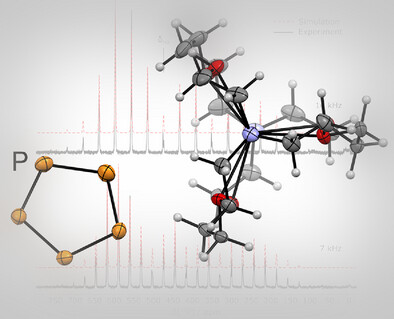
The intriguing cyclo-P5− anion, which is isolobal to the well-known cyclopentadienide anion, was characterized for the first time crystallographically in the salts [M([2.2.2]cryptand)][cyclo-P5] (M = Na, K). The compounds were further characterized by UV/Vis spectroscopy in solution and in the solid state by Raman and 31P MAS NMR spectroscopy.
Cobalt-Catalyzed Hydrotrifluoromethoxylation | Hot Paper
Cobalt-Catalyzed Enantioselective Hydrotrifluoromethoxylation of Aromatic Alkenes
- First Published: 23 March 2025
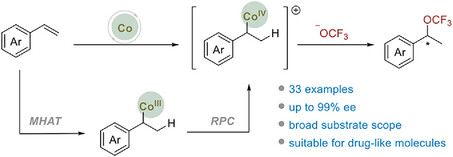
The synthesis of optically pure benzyl trifluoromethoxy (OCF3) compounds remains a challenging task. Here, we present the first enantioselective intermolecular hydrotrifluoromethoxylation reaction between aromatic alkenes and TFMS, catalyzed by chiral salen-Co complexes. This approach efficiently yields a variety of chiral benzylic trifluoromethoxy compounds with 75%–99% ee.
Chemiresistors
A Donor–Acceptor-Type Two-Dimensional Poly(Arylene Vinylene) for Efficient Electron Transport and Sensitive Chemiresistors
- First Published: 31 March 2025
Biomaterials
New Transferrin Receptor-Targeting Conjugate Effectively Delivers DNA to Mouse Brain
- First Published: 07 April 2025

We present a novel RNA aptamer targeting the transferrin receptor (TfR), conjugated with DSPE lipid, which achieves remarkably efficient brain uptake, reaching brain-to-serum ratios as high as 6.5. Through fluorescence imaging and polymerase-chain reaction analyses, we verify that this new conjugate successfully delivers a substantial amount of DNA oligonucleotide to the brains of Balb/cJ mice and demonstrates effectiveness in a human blood–brain barrier cell line model.
Tandem Catalysis
Tandem Biocatalysis to Generate Hydrogen Sulfide and Promote Endogenous Antioxidant Response
- First Published: 01 April 2025
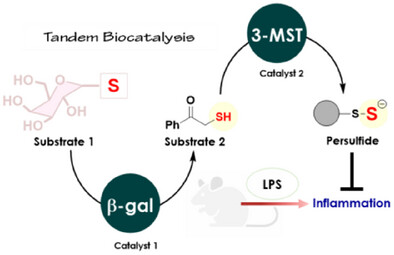
A strategy where we integrated spatially and temporally controlled catalysis in one system to promote antioxidant response is reported. We developed a glycoconjugate that is cleaved sequentially by β-galactosidase (β-gal) and 3-mercaptopyruvate sulfurtransferase (3-MST) to produce potent antioxidants persulfide and hydrogen sulfide, and this compound was found to mitigate inflammation in an animal model.
Electrosynthesis
Effect of Alternating Polarity in Electrochemical Olefin Hydrocarboxylation
- First Published: 07 April 2025
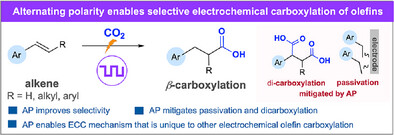
Alternating polarity (AP) is a powerful tool for controlling selectivity in olefin hydrofunctionalization, but this use is underdeveloped. Using electrochemical olefin hydrocarboxylation as a model, we highlight how AP controls product selectivity, yield, and material decomposition. It hinders overreduction, limiting dicarboxylation and electrode passivation, and facilitates a unique electrochemical–chemical–chemical (ECC) mechanism.
X-ray scintillators
Short Lifetime Radical Metal Cluster Scintillator
- First Published: 03 April 2025
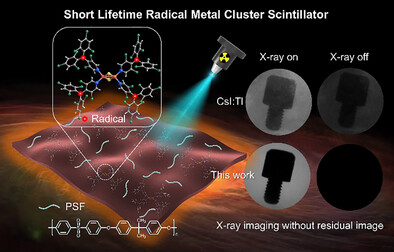
The first luminescence radical cluster was constructed with open-shell luminescent radical ligands. The spin-allowed doublet emission endows it with 100% exciton utilization and a short radiation decay lifetime on the nanosecond scale, making it suitable for high-resolution X-ray imaging without residual images.
Pernitride
High-Pressure Synthesis of Ultra-Incompressible Beryllium Tungsten Nitride Pernitride BeW10N14(N2)
- First Published: 03 April 2025
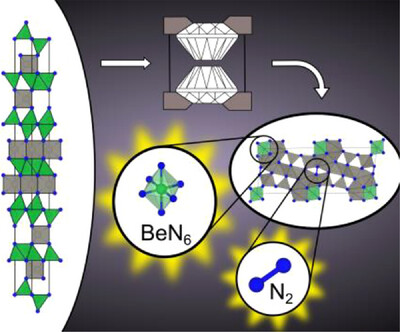
The first ternary transition metal pernitride was synthesized in a high-temperature high-pressure approach starting from W2Be4N5. The structure features not only the rare structural motif of BeN6 octahedra but also dinitrogen anions. DFT calculations reveal ultra-incompressible and metallic behavior of the new compound.
Radical Reactions
Remote Spin-Center Shift Enables Activation of Distal Benzylic C─O and C─N Bonds
- First Published: 03 April 2025
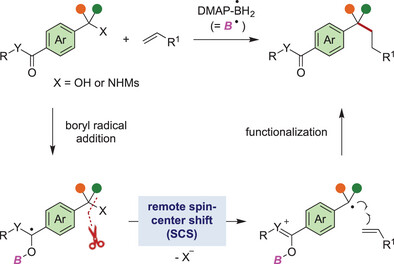
A remote spin-center shift process that involves 1,n-radical translocation followed by elimination of a leaving group has been developed to enable distal benzylic C─O and C─N bond activation. By this process, a 4-dimethylaminopyridine (DMAP)-boryl radical promoted radical deoxygenative and deaminative functionalization of free benzylic alcohols and simple benzylic amines to afford a wide range of alkylated products.
Homogeneous Catalysis
Late-Stage Cross-Electrophile Coupling of Arylthianthrenium Salts with (Hetero)aryl (Pseudo)halides via Palladium Catalysis
- First Published: 07 April 2025
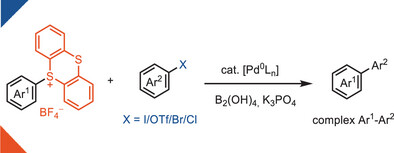
By employing complex arylthianthrenium salts and readily available (hetero)aryl (pseudo)halides as starting materials, in conjunction with hypoboric acid as a reductant, structurally diverse (hetero)biaryl motifs can be rapidly synthesized via palladium-catalyzed cross-coupling reaction. Key to this advance is the selective and mild borylation of arylthianthrenium salts, followed by a conventional SMC (Suzuki–Miyaura cross-coupling) reaction with aryl halides.
MOFs for Electrocatalysis | Hot Paper
Dimensionality Reduction of Metal–Organic Frameworks to Monolayers for Enhanced Electrocatalysis
- First Published: 07 April 2025
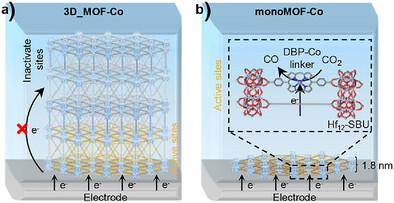
Dimensionality reduction of 3D MOFs into 1.8-nm-thick monoMOF maximizes catalytic site exposure and enhances CO2 electroreduction. The cobalt(II)–porphyrin-embedded monoMOF-Co achieves 93% CO Faradaic efficiency (versus 51% for 3D_MOF-Co) at −0.8 V versus RHE, with a 10,600 h−1 turnover frequency and 47-hour stability in near-neutral electrolyte, demonstrating superior electron/mass transfer through dimensional engineering.
Histone Acetylation
A Method for Constructing Nucleosome Arrays with Spatially Defined Histone PTMs and DNA Damage
- First Published: 07 April 2025
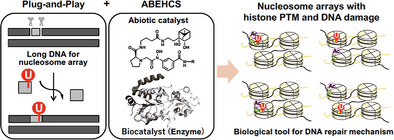
This work advances methodology by addressing challenges in mimicking the complex in vivo spatial relationships of histone acetylation and DNA damage. The combination of an abiotic/enzymatic hybrid catalyst system (ABEHCS) and the plug-and-play method has constituted a versatile platform to construct nucleosome arrays with precise histone acetylation and DNA damage patterns.
Nickel Catalysis | Hot Paper
Direct Conversion of Aromatic Lactones into Bioisosteres by Carbonyl-to-Boranol Exchange
- First Published: 07 April 2025

A nickel-catalyzed group-exchange strategy has been developed for the direct conversion of aromatic lactones into cyclic hemiboronic acid bioisosteres. Scope evaluation and product derivatization experiments demonstrate broad functional-group compatibility and the synthetic value of this strategy. Furthermore, the application of this methodology to the rapid modification of lactone cores in bioactive molecules underscores its practical utility.
Ring Expansion
Site-Selective Carbonylation of Azetidines via Copper-Catalyzed Difluorocarbene Insertion
- First Published: 07 April 2025
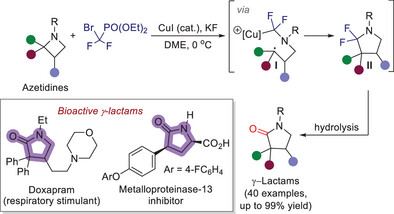
We disclose a site-selective Cu-catalyzed carbonylation of azetidines promoted by difluorocarbene insertion at low temperature, enabling access to a variety of functionalized γ-lactams and a therapeutic agent for diabetes (40 examples). This skeletal expansion strategy provides a distinct disconnection approach to synthesize medicinally relevant five-membered heterocycles.
Diradicaloids | Hot Paper
Octalenobisterphenylene and Its Diradical Dianionic Cyclodimer: Synthesis, Structural Analysis, and Properties
- First Published: 07 April 2025

Terphenylene dimer B, a fragment of the metallic (4,6,8)biphenylene network, with pronounced reactivity and strain was prepared from biaryl A by successive closures of four four-membered and two eight-membered rings. The treatment of B with sodium metal induced cyclodimerization, yielding a diradical dianion [(Na+)2(B•–)2] through a presumed radical-anion-mediated mechanism. The two spins in [(Na+)2(B•–)2] exhibit negligible mutual interaction.
Biocatalysis | Hot Paper
An Enzymatic Platform for Aniline Synthesis Through Oxidative Amination
- First Published: 07 April 2025
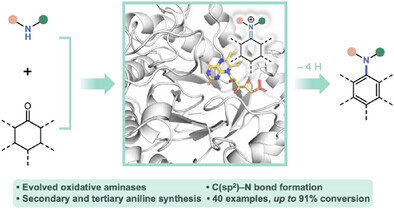
A biocatalytic platform for aniline synthesis, based on the oxidative amination of readily available cyclohexanones, has been reported. Engineered variants exhibit broad substrate compatibility, enabling the synthesis of 40 structurally diverse secondary and tertiary anilines with conversions of up to 91%. Mechanistic studies revealed that directed evolution enhanced enzyme performance in imine desaturation while suppressing phenol formation.
N2 Activation
Tetranuclear Titanium Nitride Cluster: Dinitrogen Cleavage Under Mild Conditions and Its Reactivity
- First Published: 07 April 2025
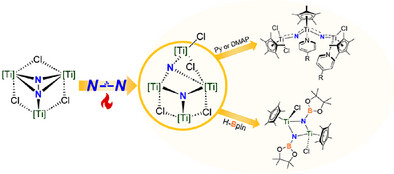
Synopsis: Heating the trinuclear Ti dinitrogen complex [{TiCp*(µ-Cl)}3(µ3-η1: η2: η2-N2)] 1(Cp* = η5-C5Me5) leads to the cleavage of N≡N bond, forming a tetranuclear titanium nitride cluster [{TiCp*}4Cl(µ-Cl)3(µ3-N)2] 2. Complex 2 reacts with pinacolborane, leading to the formation of N-B bond derivatives [{TiCp*(µ-NBpin)Cl}2]. When treated with pyridine or DMAP, complex 2 was dissociated to form a bent trinuclear Ti nitrido complex.
Cerium Oxide for CO2 Photoreduction
Boron Doping-Induced Ultrahigh Ce3+ Ratio in Amorphous CeO2/GO Catalyst for Low-Concentration CO2 Photoreduction
- First Published: 08 April 2025
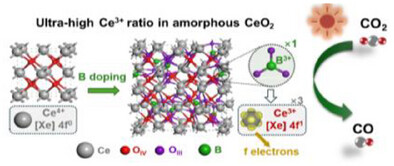
This study introduces a novel strategy to synthesize amorphous CeO2/GO with an exceptionally high Ce3+ ratio of 85.7% through B-doping. The resulting amorphous structure reduces the band gap, enhances charge separation efficiency, and significantly boosts diluted CO2 photocatalytic activity. The material achieves remarkable CO2-to-CO conversion rates of 249.33 µmol g−1 h−1(under 15% CO2) and 103.4 µmol g−1 h−1(under 1% CO2) with 100% selectivity, highlighting its potential for sustainable CO2 conversion.
Microdroplet Chemistry | Hot Paper
Cooperative Ligands
Nickel Catalysis
Nickel-Catalyzed Umpolung Difluoroalkylation of Imines Enables General Access to β-Difluoroalkylated Amines
- First Published: 09 April 2025
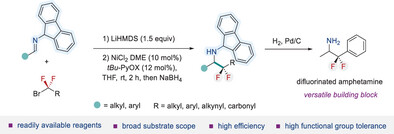
A nickel-catalyzed umpolung difluoroalkylation of Imines has been developed. By inverting the polarity of imines, this approach enables the coupling of various readily accessible difluoroalkyl bromides and iodides. The rapid fluorine replacement of bioactive molecules by the efficient synthesis of difluorinated analogs of key amine moieties present in these molecules, including amphetamine, using the current approach, demonstrates the promising potential of this protocol in advancing drug discovery and development.
Analytical Chemistry
Integrating Ambient Ionization Mass Spectrometry Imaging and Spatial Transcriptomics on the Same Cancer Tissues to Identify RNA–Metabolite Correlations
- First Published: 11 April 2025
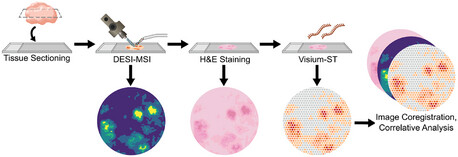
Innovations in spatial omics have advanced disease research, but spatial transcriptomics (ST) and spatial metabolomics remain separate. We present a novel method integrating DESI-MSI spatial metabolomics and Visium-ST on the same tissue sections while preserving RNA quality and data integrity. Applied to breast and lung cancer tissue, this approach reveals new metabolite-transcript correlations in cancer regions, enhancing spatial multi-omics discoveries.
Biosynthesis
Oxidative Rearrangements of the Alkaloid Intermediate Geissoschizine
- First Published: 09 April 2025
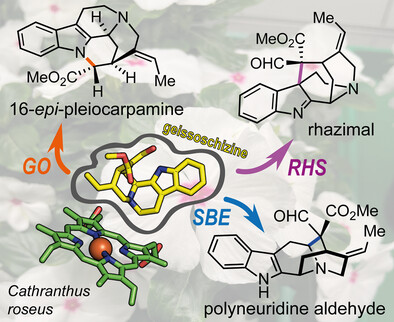
19E-geissoschizine is a key precursor in the biosynthesis of monoterpene indole alkaloids such as strychnine, ibogaine, and vinblastine. Using enzymatic assays and gene silencing, three CYPs were identified from C. roseus that oxidize this compound to four alkaloid scaffolds: strychnos, sarpagan, akuammiline, and mavacurane. Mutational analysis reveals how active-site changes fine-tune product specificity, highlighting nature's strategy for metabolic diversity.
Delayed Fluorescence
Enhanced Luminance of Pentaazaphenalene-Based Delayed Fluorescence Emitters by Breaking Forbidden Transition
- First Published: 09 April 2025
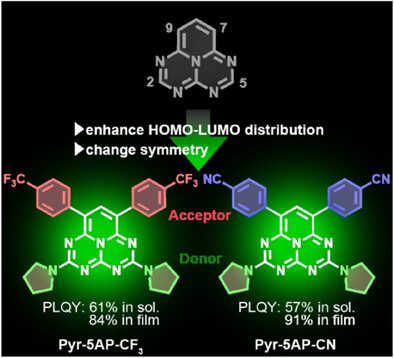
The newly developed 1,3,4,6,9b-pentaazaphenalene (5AP) based emitters with donor and acceptor units have succeeded in converting nonemissive 5AP to highly luminescent emitters by breaking the forbidden transition. These emitters exhibited photoluminescence quantum yields exceeding 80% and 90%; both are the highest among the 5AP derivatives reported to date.
Electrosynthesis | Hot Paper
Electrochemical Amination of Aryl Halides with NH3
- First Published: 09 April 2025
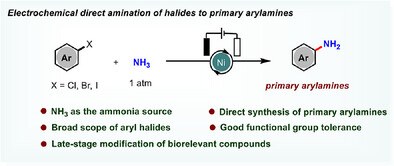
A General and Efficient Method for the Direct Synthesis of Primary Arylamines Through Electrochemical Amination of Aryl Halides With NH3 Has Been Developed. The Weak Nucleophilic Reagent NH3 Acted as an Ammonia Surrogate. This Approach Shows Good Functional Group Tolerance and a Broad Scope of Functionalized Primary Arylamines That Can be Further Late-stage Modification of Drug Molecules and Gram-scale Reaction Demonstrate Its Synthetic Utility.
Corrigendum
Correction to “Hypoxia Induced by Upconversion-Based PDT: Towards Highly Effective Bioreductive Therapy in Tumor Synergistically”
- First Published: 07 April 2025




